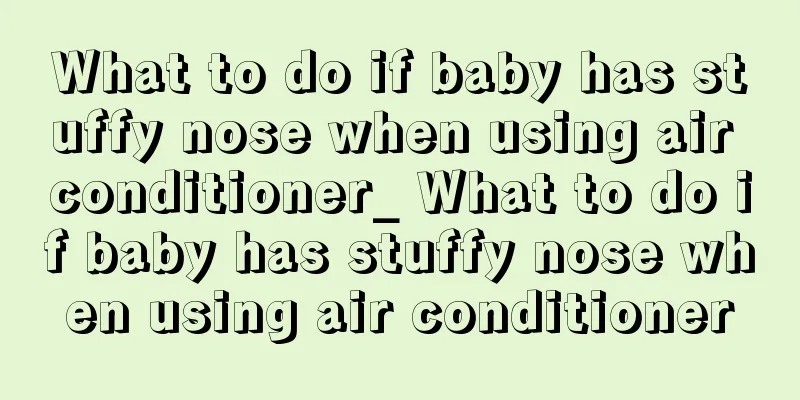What to do if baby has stuffy nose when using air conditioner_ What to do if baby has stuffy nose when using air conditioner

|
It is very common to use air conditioning in the summer, because people must use air conditioning in the summer. If they don’t use air conditioning, they will feel very hot and uncomfortable, and may even cause small bumps all over the body. However, using air conditioning for a long time can also easily cause air-conditioning disease. The most common symptom is nasal congestion. What should we do if our baby has nasal congestion due to air conditioning? The first thing you come into contact with when you enter an air-conditioned room is cold air, which stimulates the abundant peripheral nerves in the nasal mucosa, causing the nasal mucosa to contract and relax rapidly and increase the secretion of nasal glands. For patients with allergic rhinitis, this effect will be amplified, leading to symptoms such as runny nose and sneezing. It is recommended that people who are sensitive to cold air stand at the entrance for a while before entering the air-conditioned room to allow their nasal cavity to adapt to the temperature difference before entering; when using the air conditioner at home, the temperature should not be too low, and you should not sleep facing the air outlet of the air conditioner and try to cover yourself with a blanket. Raising the air conditioner temperature can not only relieve symptoms such as nasal congestion, runny nose, and sneezing, but also reduce the possibility of catching a cold due to air conditioning. Some people suffer from allergies not because they are not adapted to cold air, but because of the dust and dust mites brought by air conditioning. An air conditioner filter that has been used for many years and has not been cleaned may be attached with a large amount of tiny particles of dust and dust mites. Once the air conditioner blows out air, the dust and mites on the filter will be stirred up and fly everywhere. Because air conditioning is turned on, people often keep doors and windows closed, which prevents dust and mites from drifting outdoors. When indoor dust and mites reach a certain level, allergic rhinitis will occur, with symptoms of nasal congestion and clear runny nose. If infected by bacteria, purulent runny nose will also occur. Patients with allergic rhinitis should pay more attention to regular cleaning of air-conditioning filters, open windows in air-conditioned rooms for ventilation, and regularly clean carpets and various cotton fabrics and dry them in the sun. Patients with mild symptoms after entering an air-conditioned room do not need medication; patients with more obvious symptoms can take antihistamines to relieve the symptoms. If the symptoms still do not improve, they need to go to the otolaryngology department for regular treatment of allergic rhinitis. |
<<: What to do if your child has a stuffy nose and can't sleep well
>>: What to do if your 50-day-old baby has a stuffy nose
Recommend
What are the best ways to train abdominal muscles for children?
Nowadays, many young people like to exercise thei...
What should I do if my child gets angry easily?
Everyone has times when they feel irritated or de...
The reason why the baby has small red spots all over his body
It is very easy for people to get allergies in sp...
What should I do if my 4-year-old child has a poor appetite?
Babies' appetite seems to decrease more easil...
What are the symptoms of heart disease in children?
Heart disease is a common circulatory system dise...
Side effects of rabies vaccination for children
Children are young, and side effects are inevitab...
My daughter has small pimples on her hands
Many parents will find that their daughters have ...
When can babies eat rice?
For children, milk is their only food when they a...
Nursing of children with fecal incontinence
The most painful thing is when a child is sick, a...
What are the ways to relieve toothache caused by tooth decay in children?
Children tend to eat sweet foods, such as candy, ...
What is the white spot on the tip of the newborn's nose?
People who have given birth to a baby or have a b...
When should the neonatal dressing be removed?
When the fetus is in the mother's body, it is...
How to correct the phenomenon of children's hunchback
It is not difficult to find that many children on...
Newborn vomits yellow-green liquid
If a newborn vomits yellow-green liquid, it is co...
Newborn baby mouth foaming
The only food options for newborns after birth ar...









